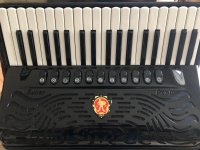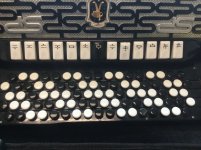You are using an out of date browser. It may not display this or other websites correctly.
You should upgrade or use an alternative browser.
You should upgrade or use an alternative browser.
what does the symbol for the two registers on the right mean?
- Thread starter zauheimu
- Start date
- Status
- Not open for further replies.
Dingo40
Been here for ages!
Good question: never seen these before!?
If I were to guess these look like "distorted" registers, meaning they do not open the corresponding register slides completely, creating an out-of-tune (distorted) effect. But I have never actually tried an accordion with these registers, so consider it just an (educated?) guess.
Dingo40
Been here for ages!
Then, again, this accordion has two M registers.
The combinations LM and MH are repeated.
Could it be that one repeat involves the "straight" M reed, the other the detuned M reed??
The combinations LM and MH are repeated.
Could it be that one repeat involves the "straight" M reed, the other the detuned M reed??
Last edited:
Is it possible that it has to do with a Cassotto? Someone on reddit suggested the following:
IIRC, those symbols typically mean 'The low reeds + the non-cassotto middle reeds' and 'The non-cassotto middle reeds + the high reeds'. On all the other registers, if only one middle dot is shown, it implies its using the middle reed block that's mounted to the tone chamber.
In other words, your accordion probably has the low reed block and one of the two middle reed blocks on the tone chamber. For all registers except the last two, if one middle reed block is used, it's the one on the tone chamber.
Jim, are you confirming that (a) there is no cassotto and (b) the symbol refers to "low reeds plus detuned middle reeds" and "detuned middle reeds plus high reeds"? Are there any references to this online (manuals?, these symbols being used elsewhere?)?Your guess was right on Dingo !!!
Interesting. For the detuned middle reed I've always just seen an off-center dot, not this "stripe" notation.Your guess was right on Dingo !!!
Gonk
http://mudlark-music.com
This conversation is happening in two places at once, so it might be useful to put it all on the table here:
 www.reddit.com
www.reddit.com
Reddit - The heart of the internet
Generally, Paolo Soprani uses “Super Paolo” to identify their models with cassotto, so I would think that this accordion does have a cassotto.Jim, are you confirming that (a) there is no cassotto and (b) the symbol refers to "low reeds plus detuned middle reeds" and "detuned middle reeds plus high reeds"? Are there any references to this online (manuals?, these symbols being used elsewhere?)?
I can confirm that it is a Super Paolo. The good folks at reddit have been very helpful as well, but it is fascinating to see that no one appears to have first-hand experience with these symbols. Considering that it is a Super Paolo, my best hypothesis at this point is that the symbols indicate that the middle reed used is not the one "in the cabin", i.e. Cassotto. It's also my favourite hypothesis, as I want to own a Cassotto accordion. The Paolo accordion is heavy compared to my Hohner full size accordion, which confirms the hypothesis, and so does a (very much non-expert) sound comparison between the different switches.
The description on Reddit implies that this is an accordion with a single tone chamber. I was under the impression that single chamber accordions generally had only the bassoon (16’) reed set in the chamber. If this is true, then the symbol does not seem to refer to the cassotto since it is not shown as applying to the 16’ reed bank only but seems more closely associated with the 8’ reed bank.I can confirm that it is a Super Paolo. The good folks at reddit have been very helpful as well, but it is fascinating to see that no one appears to have first-hand experience with these symbols. Considering that it is a Super Paolo, my best hypothesis at this point is that the symbols indicate that the middle reed used is not the one "in the cabin", i.e. Cassotto. It's also my favourite hypothesis, as I want to own a Cassotto accordion. The Paolo accordion is heavy compared to my Hohner full size accordion, which confirms the hypothesis, and so does a (very much non-expert) sound comparison between the different switches.
Last edited:
Dingo40
Been here for ages!
Zauheimu,
The "SP" logo on the grill seems to confirm the accordion being a "Super Paolo" in any case : congratulations on a fine instrument !?
The "SP" logo on the grill seems to confirm the accordion being a "Super Paolo" in any case : congratulations on a fine instrument !?
Gonk
http://mudlark-music.com
zauheimu, it's a lovely instrument - I think it's a good one to own regardless of which reed is chambered. That said, it is likely to be the L reed in the chamber, not the M. (Edit: sorry Scuromondo, I see you just said the same thing)
P.S: the "SP" grill is also a "PS" grill, depending on how you look at it, which might stand for "Paolo Soprani." They're used on the "Professionale" series too, possibly others...
P.P.S: Oh, I think I see what you're saying, Dingo. The silver hilight of the "SP" doesn't seem to appear on the Professionale series.
P.S: the "SP" grill is also a "PS" grill, depending on how you look at it, which might stand for "Paolo Soprani." They're used on the "Professionale" series too, possibly others...
P.P.S: Oh, I think I see what you're saying, Dingo. The silver hilight of the "SP" doesn't seem to appear on the Professionale series.
Last edited:
Yes, they use a sort of double meaning. All models of this period have grills with that “PS” pattern in black, but only the Super Paolo also includes “SP” in silver or white. The new Professionale models still use the PS pattern, but the grill on the Super Paolo is now noticeably different. ...I just bought a new Super Paolo last month, so I’m quite sure about that!
In any case, I agree that it this a good looking accordion!
In any case, I agree that it this a good looking accordion!
Scuromondo, does your Super Paolo have a Cassotto? Do you have strange symbols on your registers?
Thank you, Gonk, for all your help! I am still somewhat unsure if we've come to a definitive conclusion. I just looked up super paolo soprani with cassotto on ebay, and I could find no other accordion with these symbols.
Thank you, Gonk, for all your help! I am still somewhat unsure if we've come to a definitive conclusion. I just looked up super paolo soprani with cassotto on ebay, and I could find no other accordion with these symbols.
Gonk
http://mudlark-music.com
zauheimu, since you already have the grill off, just look at the pallet rods. A cassotto instrument will have an extra arm on each rod, going into the instrument, like this:
Happy to try to help, and equally intrigued by your strange symbols. As for those, I think the only way you'll get a definite conclusion is by checking out what the register shutters do when you press them.
Code:
|| <-- normal pallet
|
==------| <-- cassotto pallet
|
|___________=============== <-- keyHappy to try to help, and equally intrigued by your strange symbols. As for those, I think the only way you'll get a definite conclusion is by checking out what the register shutters do when you press them.
Here's a Super Paolo musette cassotto with the similar register markings:
Which raises the question of how the 2 violin switches differ.
Paolo Soprani Super Paolo 120 Bass Accordion
Paolo Soprani Super Paolo 120 Bass Accordion, A top quality accordion from the famous Paolo Soprani factory, the worlds oldest accordion maker.
theaccordionshop.co.uk
Which raises the question of how the 2 violin switches differ.
Mine does have a double cassotto and it has no markings. But mine is not a double octave accordionScuromondo, does your Super Paolo have a Cassotto? Do you have strange symbols on your registers?
Thank you, Gonk, for all your help! I am still somewhat unsure if we've come to a definitive conclusion. I just looked up super paolo soprani with cassotto on ebay, and I could find no other accordion with these symbols.

Dingo40
Been here for ages!
Thanks for sharing the above pictures, Glug?
So what do we have?
Bandoneon reed only in cassotto.
But, only one coupler displays the bandoneon marking and both have the mysterious, other symbol.
So, the mystery symbol shouldn't relate to cassotto?
Also, each right hand coupler already has a twin, except for also having the mystery mark.
And, the mystery mark changes location from coupler to coupler.
So what's different between having the mystery mark and not having it??
Beats me?
So what do we have?
Bandoneon reed only in cassotto.
But, only one coupler displays the bandoneon marking and both have the mysterious, other symbol.
So, the mystery symbol shouldn't relate to cassotto?
Also, each right hand coupler already has a twin, except for also having the mystery mark.
And, the mystery mark changes location from coupler to coupler.
So what's different between having the mystery mark and not having it??
Beats me?
Last edited:
- Status
- Not open for further replies.
Similar threads
- Replies
- 18
- Views
- 385
- Replies
- 1
- Views
- 115
- Replies
- 8
- Views
- 359

